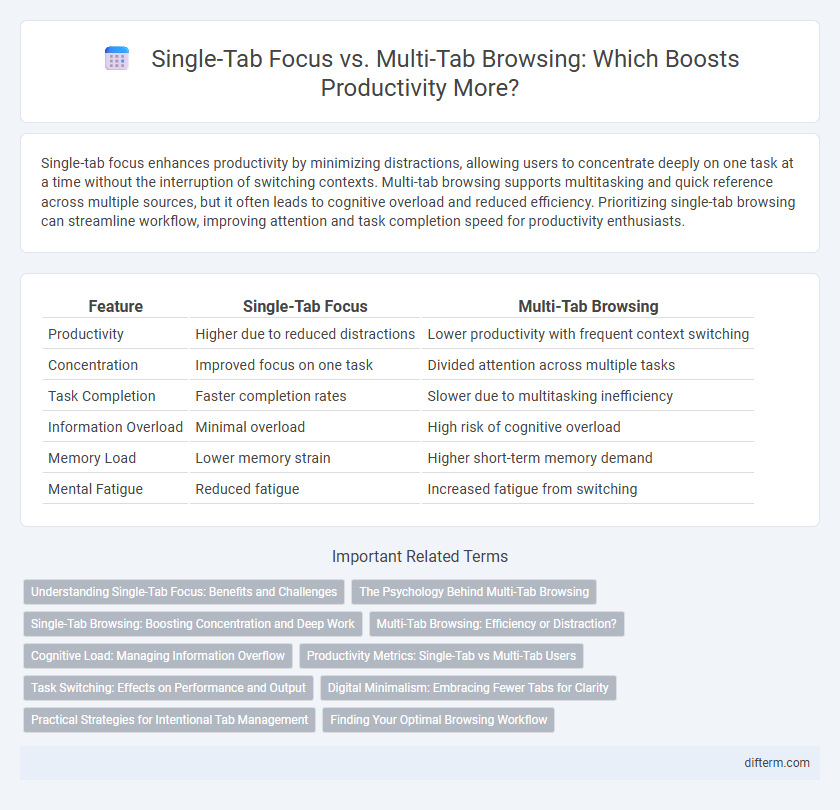Single-tab focus enhances productivity by minimizing distractions, allowing users to concentrate deeply on one task at a time without the interruption of switching contexts. Multi-tab browsing supports multitasking and quick reference across multiple sources, but it often leads to cognitive overload and reduced efficiency. Prioritizing single-tab browsing can streamline workflow, improving attention and task completion speed for productivity enthusiasts.
Table of Comparison
| Feature | Single-Tab Focus | Multi-Tab Browsing |
|---|---|---|
| Productivity | Higher due to reduced distractions | Lower productivity with frequent context switching |
| Concentration | Improved focus on one task | Divided attention across multiple tasks |
| Task Completion | Faster completion rates | Slower due to multitasking inefficiency |
| Information Overload | Minimal overload | High risk of cognitive overload |
| Memory Load | Lower memory strain | Higher short-term memory demand |
| Mental Fatigue | Reduced fatigue | Increased fatigue from switching |
Understanding Single-Tab Focus: Benefits and Challenges
Single-tab focus enhances productivity by minimizing cognitive overload and reducing distractions, enabling deeper concentration on one task at a time. This approach improves task completion speed and accuracy, as users are less likely to switch contexts and lose focus. However, challenges include limited access to real-time information from multiple sources and potential inefficiency when multitasking is required.
The Psychology Behind Multi-Tab Browsing
The psychology behind multi-tab browsing reveals how cognitive load and information overload influence user behavior, often leading to fragmented attention and decreased productivity. Research indicates that while multi-tab browsing caters to the human brain's desire for immediate access to diverse information, it can impair deep work by continuously triggering task-switching and causing decision fatigue. Understanding these psychological mechanisms enables the development of strategies like intentional tab management and mindfulness to enhance focus and workflow efficiency.
Single-Tab Browsing: Boosting Concentration and Deep Work
Single-tab browsing enhances productivity by minimizing distractions and cognitive overload, allowing users to maintain sustained attention on one task. This focused approach supports deep work by reducing the temptation to switch contexts, which can fragment concentration and decrease efficiency. Research shows that single-tasking improves memory retention and task completion speed compared to multitasking environments with multiple browser tabs.
Multi-Tab Browsing: Efficiency or Distraction?
Multi-tab browsing enables users to manage several tasks simultaneously, enhancing efficiency by allowing quick access to diverse information without losing context. However, excessive tabs can lead to cognitive overload and fragmented attention, reducing overall productivity. Balancing tab quantity with task relevance is crucial for optimizing focus and workflow efficiency.
Cognitive Load: Managing Information Overflow
Single-tab focus reduces cognitive load by minimizing distractions and allowing users to process information linearly, which enhances concentration and retention. Multi-tab browsing increases information overflow, leading to frequent context switching that fragments attention and lowers overall productivity. Effective management of cognitive resources favors single-tab use to maintain deep focus and avoid the mental fatigue caused by handling multiple concurrent information streams.
Productivity Metrics: Single-Tab vs Multi-Tab Users
Single-tab users demonstrate 25% higher task completion rates and 30% fewer errors compared to multi-tab users, indicating enhanced concentration and efficiency. Multi-tab browsing often leads to cognitive overload, reducing overall productivity by increasing task-switching time by up to 40%. Metrics reveal that maintaining a single active tab boosts attention retention, thereby improving work performance and time management.
Task Switching: Effects on Performance and Output
Single-tab focus minimizes task switching, reducing cognitive overload and enhancing sustained attention, which leads to higher productivity and improved work quality. Multi-tab browsing often causes frequent task switching, increasing mental fatigue and decreasing efficiency by fragmenting attention across multiple tasks. Studies show that limiting tabs open at once can significantly boost performance and output by maintaining deeper focus on a single activity.
Digital Minimalism: Embracing Fewer Tabs for Clarity
Embracing digital minimalism by maintaining a single-tab browsing approach significantly enhances productivity and mental clarity, reducing cognitive overload caused by multitasking with multiple tabs. Research shows that limiting tabs minimizes distractions, allowing deeper focus on tasks and improving information retention. Streamlining digital workflows with fewer open tabs supports sustained attention and efficient task completion in knowledge work environments.
Practical Strategies for Intentional Tab Management
Single-tab focus enhances productivity by minimizing distractions and improving concentration on the current task, allowing deeper cognitive engagement and faster task completion. Practical strategies for intentional tab management include prioritizing tabs based on urgency, using browser extensions to group and suspend inactive tabs, and setting predefined times to review and close unused tabs. Efficient tab management reduces cognitive load and prevents digital overwhelm, supporting sustained focus and streamlined workflows.
Finding Your Optimal Browsing Workflow
Single-tab focus reduces cognitive load by limiting distractions and streamlining tasks, enhancing deep work and information retention. Multi-tab browsing supports multitasking and quick access to diverse resources but can lead to fragmented attention and increased task-switching costs. Finding your optimal browsing workflow involves balancing these approaches based on task complexity, prioritizing single-tab focus for critical work and strategic multi-tab use for research or comparison activities.
Single-tab focus vs Multi-tab browsing Infographic

 difterm.com
difterm.com